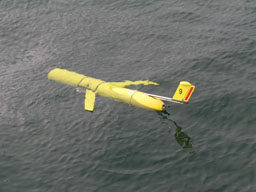“Gliders” Coming of Age for Ocean Acoustic Monitoring
Bioacoustics, Ocean, Science, Sonar Add commentsOne of the more exciting new technologies to come of age in the past couple years is ocean “gliders” that can cruise the seas, silently or nearly so, while collecting data ranging from temperature and salinity to sounds. The gliders are small (roughly 6 feet long), and surface periodically to send data to satellite communication systems. Some gliders are battery powered and can cruise for about a month, while the leading edge approach is to use a temperature-sensitive ballast that allows the glider to travel for up to five years at sea. As a tool for working with ocean noise issues, gliders hold great promise for use in monitoring the seas before sonar trials, as well as for regional acoustic mapping/monitoring. In late 2007, researchers at Defense Research and Development Canada used a glider to listen in on beaked whale calls; recording and analysis take place while the glider is below the surface; by the time it surfaces to send its data to researchers on shore, “it already thinks it knows whether it has a beaked whale or a sperm whale,” according to lead researcher Jim Theriault. The US Navy has a few training ranges where bottom-mounted hydrophones make it much easier to monitor for beaked and other whales before and during sonar exercises; gliders could bring this advanced capability to sonar training anywhere at sea.

WHOI glider in the water
This spring, the US Navy placed orders for $6 million worth of Littoral Battlespace Sensing-Gliders (LBS-G), with options for up to $50 million more over the next four years. It appears that, at least for now, the Navy is planning to use the gliders as part of their near-shore (littoral) defense system, rather than as adjuncts to monitor for whales near sonar exercises. Early this year, the NATO Undersea Research Group (NRUG) ordered 4 to 7 gliders, though it’s unclear whether they will be outfitted with hydrophones. At Woods Hole, Mark Baumgartner’s research group has been using a fleet of 20 gliders (which were initially developed at Woods Hole, before being commercialized by a WHOI scientist) to listen in on baleen whales as they study whale distribution and habitat in the Gulf of Maine; however, before long-term deployment and research can begin, the team is developing instruments and software to allow for near real-time assessment and classification of the sounds. Once that’s up to speed, larger scale monitoring can begin. Non-acoustic gliders are in use worldwide by Rutgers researchers, where the Coastal Ocean Observation Lab (COOL) has been using them since 2003.
Gliders hold great promise as a benign yet active platform for ocean observing, especially in acoustics. Any boat-based monitoring brings its own noise along for the ride, while bottom-mounted hydrophones need more complex communication systems (generally cables). Gliders are effectively silent, and move so slowly that even in the case of a fluke collision with a sea creature, no harm will come to either party. Keep an eye on this exciting new technology!
